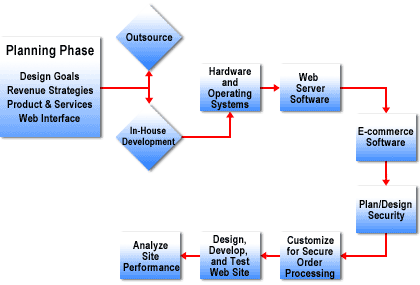Lesson 1
Planning ecommerce Site Implementation
Taking the time to plan your e-commerce website may be time consuming, but it is an essential step in the development process.
There are as many design options as there are businesses, but you want to make sure you pick the option that best meets the goals of your company. Properly planning the development and deployment of your website will increase quality and decrease development time.
This module introduces you to the planning stage involved in designing your e-commerce business.By the end of this module, you will know how to:
There are as many design options as there are businesses, but you want to make sure you pick the option that best meets the goals of your company. Properly planning the development and deployment of your website will increase quality and decrease development time.
This module introduces you to the planning stage involved in designing your e-commerce business.By the end of this module, you will know how to:
- Outline the process for planning and designing a site
- Describe the steps involved in designing an e-commerce Website
- Formulate the design goals for your e-commerce site
- Meet your customers expectations with archetypes
- Develop a storyboard to outline your plans
- Assess outsourcing options for your e-commerce solution
Throughout this course, we will use the storyboard shown below to illustrate the sequence of events occurring in e-commerce Web site development. This particular storyboard is designed to emphasize essential steps throughout this course. Each module will add to this storyboard. After you have taken a look, let's examine some of the details.
Archetypes are used for modeling the e-commerce Process
The concept of archetypes is still used for modeling the e-commerce process. Archetypes are a way of representing common patterns in data.
They can be used to understand the different ways that customers interact with an e-commerce website, and to identify areas where the website can be improved.
There are a number of different ways to use archetypes for e-commerce modeling. One common approach is to use archetypes to create customer personas. Customer personas are fictional representations of real customers, based on their demographics, interests, and buying habits. By understanding the different personas that visit an e-commerce website, businesses can better tailor their products, services, and marketing campaigns to meet the needs of their customers.
Archetypes can also be used to identify areas where an e-commerce website can be improved. For example, if a website's checkout process is complex and difficult to use, archetypes can be used to identify the specific steps in the process that are causing problems for customers. This information can then be used to redesign the checkout process to make it easier and more efficient for customers to use. Overall, the concept of archetypes is a powerful tool that can be used to improve the e-commerce process. By understanding the different ways that customers interact with an e-commerce website, and by identifying areas where the website can be improved, businesses can increase sales and improve customer satisfaction.
Here are some of the benefits of using archetypes for e-commerce modeling:
If you are looking for a way to improve your e-commerce business, I recommend considering using archetypes for modeling.
Archetypes can also be used to identify areas where an e-commerce website can be improved. For example, if a website's checkout process is complex and difficult to use, archetypes can be used to identify the specific steps in the process that are causing problems for customers. This information can then be used to redesign the checkout process to make it easier and more efficient for customers to use. Overall, the concept of archetypes is a powerful tool that can be used to improve the e-commerce process. By understanding the different ways that customers interact with an e-commerce website, and by identifying areas where the website can be improved, businesses can increase sales and improve customer satisfaction.
Here are some of the benefits of using archetypes for e-commerce modeling:
- Improved understanding of customer behavior: Archetypes can help businesses to better understand how their customers interact with their website, which can lead to improved product development, marketing, and customer service.
- Increased sales: By understanding the different personas that visit their website, businesses can better tailor their products and services to meet the needs of their customers, which can lead to increased sales.
- Improved customer satisfaction: By identifying and addressing areas where their website is causing problems for customers, businesses can improve customer satisfaction.
If you are looking for a way to improve your e-commerce business, I recommend considering using archetypes for modeling.

Dropshipping